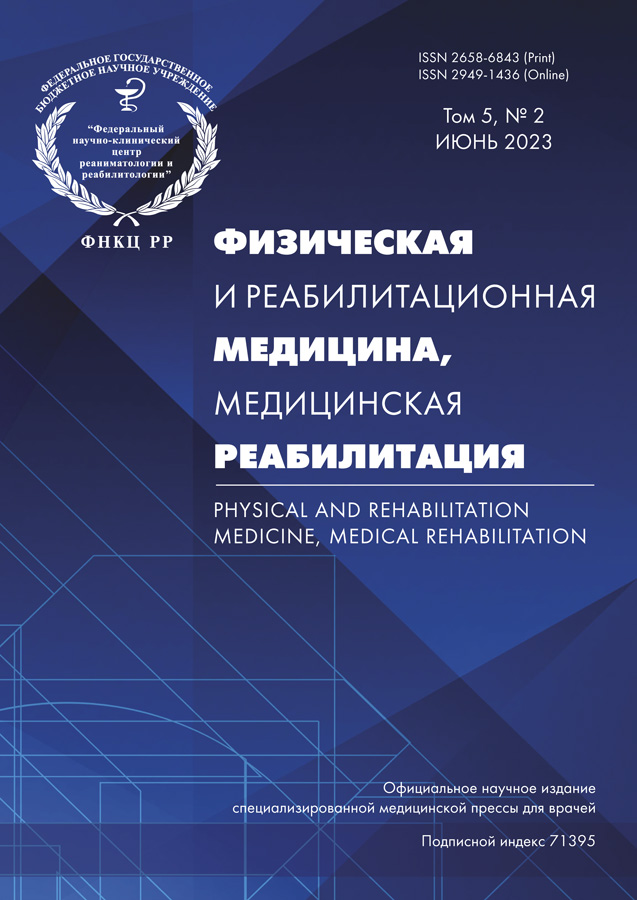Significance of the second stage of medical rehabilitation after arthroplasty of large joints
- 作者: Nikolaev N.S.1,2, Petrova R.V.1,2, Preobrazhenskaya E.V.1, Ivanov M.I.1, Trifonova O.V.1
-
隶属关系:
- Federal Center for Traumatology, Orthopedics and Arthroplasty (Cheboksary)
- Chuvash State University
- 期: 卷 5, 编号 2 (2023)
- 页面: 97-106
- 栏目: ORIGINAL STUDY ARTICLE
- URL: https://journals.rcsi.science/2658-6843/article/view/132874
- DOI: https://doi.org/10.36425/rehab114766
- ID: 132874
如何引用文章
全文:
详细
BACKGROUND: Until recently, the three-level system of medical rehabilitation adopted in Russia assumed the implementation of each of the stages in various medical organizations. The lack of funding within the budget and the basic compulsory medical insurance program led to limited access for patients to the trajectory of the completed cycle of medical rehabilitation after surgical interventions, which reduced the effectiveness of the provision of profile high-tech medical care.
AIM: is to demonstrate the effectiveness of the system for organizing rehabilitation care for patients after arthroplasty of large joints of the lower extremities in a stationary (second) stage in a medical rehabilitation center.
MATERIALSAND METHODS: The data of the medical information system on patients treated for three months at the second (inpatient) stage after arthroplasty of the hip and knee joints in the conditions of the Medical Rehabilitation Center were used. The effectiveness of rehabilitation was assessed by tests and scales: rehabilitation routing scale (RRS), visual analog scale (VAS), Borg exercise tolerance scale, Hospital anxiety and depression scale (HADS), European quality of life questionnaire (EQ-5D); Medical research scale (MRS), index Leken.
RESULTS: 308 patients (306 operated) were treated after medical rehabilitation measures at the first stage with a RRS score of 4-5 points, of which about 80% — after primary and revision arthroplasty of large joints. Upon completion of rehabilitation measures, a statistically significant improvement in all functional indicators was noted. Despite the ambiguous opinion of scientists about the need for inpatient rehabilitation after arthroplasty, according to our data, arthroplasty and the subsequent stage of medical rehabilitation using modern technologies in a hospital significantly improve the clinical status, reduce or eliminate pain, increase motor activity, improve the psycho-emotional background and the patient s quality of life. Stationary (second) stage of rehabilitation was effective in 100%.
CONCLUSIONS: The results of the work of the medical rehabilitation center proved its organizational feasibility, clinical effectiveness and advantages: continuity and phasing of rehabilitation in a single institution; continuity of observation of the patient during the interaction of multidisciplinary rehabilitation team with the participation of the operating surgeon, an anesthesiologist-resuscitator. The quality of rehabilitation is improved by the concentration of high-tech therapeutic and regenerative agents and experienced specialists, the correction of concomitant pathology, explanatory work with patients to increase compliance.
作者简介
Nikolay Nikolaev
Federal Center for Traumatology, Orthopedics and Arthroplasty (Cheboksary); Chuvash State University
Email: nikolaevns@mail.ru
ORCID iD: 0000-0002-1560-470X
SPIN 代码: 8723-9840
Scopus 作者 ID: 57200249359
Dr. Med. Sci., Professor of RAS, Chief Physician, Head of the Department of Traumatology, Orthopedics and Extreme Medicine
俄罗斯联邦, 33, F. Gladkova street, Cheboksary, Chuvash Republic, 428020; 15, Moskovskii, Cheboksary, Chuvash Republic, 428015Roza Petrova
Federal Center for Traumatology, Orthopedics and Arthroplasty (Cheboksary); Chuvash State University
Email: rpetrova@orthoscheb.com
ORCID iD: 0000-0002-9596-4309
Head of the Department of Early Medical Rehabilitation of the Center for Medical Rehabilitation - Doctor of Physical and Rehabilitation Medicine, Senior Lecturer, Department of Traumatology, Orthopedics and Extreme Medicine
俄罗斯联邦, 33, F. Gladkova street, Cheboksary, Chuvash Republic, 428020; 15, Moskovskii, Cheboksary, Chuvash Republic, 428015Elena Preobrazhenskaya
Federal Center for Traumatology, Orthopedics and Arthroplasty (Cheboksary)
Email: alenka_22@bk.ru
ORCID iD: 0000-0003-3556-145X
SPIN 代码: 1525-3912
Head of Scientific and Educational Department 俄罗斯联邦, 33, F. Gladkova street, Cheboksary, Chuvash Republic, 428020
Mikhail Ivanov
Federal Center for Traumatology, Orthopedics and Arthroplasty (Cheboksary)
Email: mivanov@orthoscheb.com
ORCID iD: 0000-0001-9852-7086
Head of the inpatient department of medical rehabilitation
俄罗斯联邦, 33, F. Gladkova street, Cheboksary, Chuvash Republic, 428020Ol'ga Trifonova
Federal Center for Traumatology, Orthopedics and Arthroplasty (Cheboksary)
编辑信件的主要联系方式.
Email: trifonova@orthoscheb.com
ORCID iD: 0000-0001-5203-5393
traumatologist-orthopedist of the inpatient department of medical rehabilitation
俄罗斯联邦, 33, F. Gladkova street, Cheboksary, Chuvash Republic, 428020参考
- Somov DA, Makarova MR, Filippov MS, et al. Some aspects in improving approaches to the medical rehabilitation of patients after total knee arthroplasty. Issues of balneology, physiotherapy and therapeutic physical culture. 2021;98(3-2): 184-185. (In Russ), doi: 10.17116/kurort20219803221
- Fedonnikov AS. Medical rehabilitation of patients after total hip and knee arthroplasty: Problems of organization and resource provision. Saratov Scientific Medical Journal. 2019; 15(4):920-924. (In Russ).
- Khozyainova SS, Abuseva GR, Adkhamov BM, Shishkin YuM. Passive mechanotherapy in the rehabilitation of patients after hip and/or knee arthroplasty. Medical Rehabilitation: Research and Clinical Practice: Collection of Abstracts of the First International Congress, 05-06 April 2022. Saint Petersburg: Chelovek i ego zdorov'e; 2022. P. 369-370. (In Russ).
- Petrova RV, Nikolaev NS, Tsykunov MB. Rehabilitation approaches for knee arthroplasty. Bulletin of Rehabilitation Medicine. 2022; 21(2)61-69. (In Russ), doi: 10.38025/2078-1962-2022-21-2-61-69
- Achkasov SI, Gubaidullin RR, Ermakov NA, et al. The program of accelerated recovery of surgical patients Fast track. Ed. by 1.1. Zatevakhin, et al. Moscow: GEOTAR-Media, 2017. 207 p.
- Pogonchenkova IV, Sapozhnikov P. A multidisciplinary approach is basic in providing medical rehabilitation assistance. Moscow medicine. 2018;(5):6—19. (In Russ).
- Blinov DV, Solopova AG, Sandzhieva LN, et al. Improving the organization of medical rehabilitation in the healthcare system: Situation analysis. Pharmacoeconomics. Modern pharmacoeconomics and pharmacoepidemiology. 2022; 15(2):237—249. (In Russ), doi: 10.17749/2070-4909/farmakoekonomika.2022.140
- Asilova SU, Ruzibaev DR. Medical and social examination and rehabilitation of patients and disabled persons after the hip total arthroplasty. Genij ortopedii. 2015;(2):36—39. (In Russ).
- Medical Advisory Secretariat. Physiotherapy rehabilitation after total knee or hip replacement: An evidence-based analysis. Ont Health Technol Assess Ser. 2005;5(8): 1—91.
- Coulter C, Perriman DM, Neeman TM, et al. Supervised or unsupervised rehabilitation after total hip replacement provides similar improvements for patients: A randomized controlled trial. Arch Phys MedRehabil. 2017;98(11 >2253-2264. doi: 10.1016/j.apmr.2017.03.032
- Malik IV, Devasenapathy N, Kumar A, et al. Estimation of expenditure and challenges related to rehabilitation after knee arthroplasty: A hospital-based cross-sectional study. Indian J Orthop. 2021;55(5):1317-1325. doi: 10.1007/s43465-021 -00405-6.
补充文件







